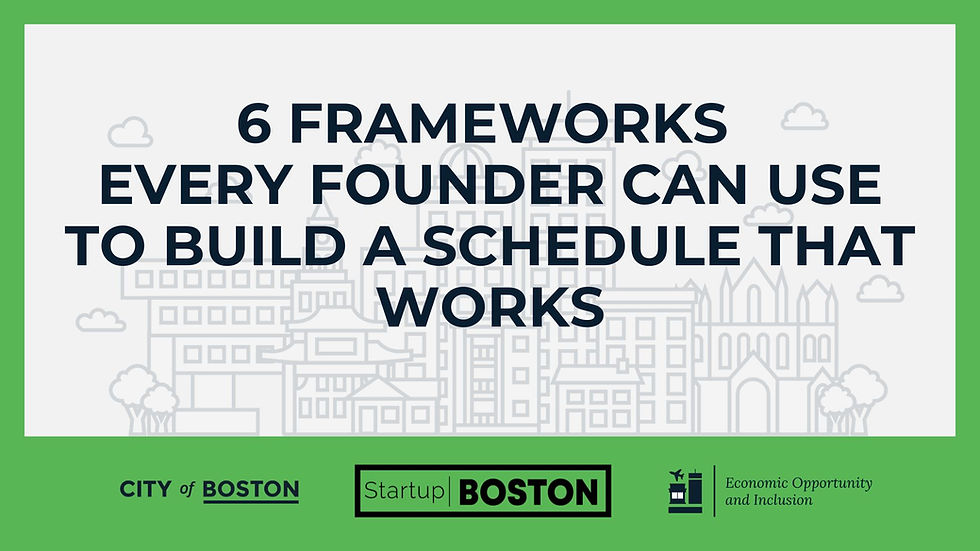Shared Cent-iments: Bootstrapping and Crowdfunding
- Chip Daley

- Nov 11, 2021
- 3 min read
Updated: Dec 15, 2022
Founders and young companies can be overwhelmed by funding options; not to mention the company’s bottom line, month to month budget, and speed to market. In order to navigate the many financial challenges for a startup, Startup Boston presented “Shared Cent-iments: Bootstrapping and Crowdfunding,” a panel of crowdfunding platform executives weighing in on the options before securing your cash runway.
Throughout the chat, panelists Ahmed Malik, CEO of Sparrow Labs, Oriana Papin-Zoghbi, CEO & Co-Founder of AOA, and Adam Roberts, Founder In Residence at Wefunder and moderator, Madison Rifkin, CEO of Mount, gave their perspective of what crowdfunding investors look for in an early stage startup, as well as a sense of how to generate excitement among many diverse micro investors. While all three panelists shared unique experiences and a plethora of knowledge with the group, there were a few key themes highlighted from the hour of discussion.
1. Start by tapping into your own network
When searching for investors, Ahmed, Oriana, and Adam all agreed that founders should reach out to friends and family as a starting point. “Share your idea with them (friends and family) without asking for any money first. Most of the time, they can think of people in their own networks or may volunteer themselves up for investing,” said Oriana.
Having conversations with the highest accredited investors right off the bat is often not the right approach. The company pitch is likely to evolve over time, especially in the early stages following the founding. In order to maximize the benefit of your immediate network, be ready to share basic investment knowledge with them and spell out every aspect of potential value that the business will have.
2. Create a network of trust and belief
Following initial investment from friends and family, establishing a base of loyal customers and investors early on in the process who trust your product is key.
One of the best parts about equity fundraising is that the investors don’t have to be accredited, and thus, it's most important to focus on rallying a base of people who believe in you. “There is a lot of wisdom to be had in not fundraising,” explained Adam. “You can learn quickly who your customers are and what kind of demand there is.”
3. Fundraise, but don’t waste time.
A lot of time is spent on setting fundraising goals, networking, and getting investors on board. While raising outside capital is certainly important, remember that the founder’s job is to run the company, not to fundraise. Close the round as quickly as possible and get back to work with the money that you do have. “Do the best with the capital that you were able to raise; you can go back out and raise again in the future,” said Oriana.
In terms of fundraising strategy, “set a realistic goal,” explained Ahmed, “as it's always better to look oversubscribed. If you are not able to reach your goal, though, think about what that means in relation to how much past or short of the goal you were.” While not reaching a fundraising goal can be disheartening, take it instead as an opportunity to learn and understand the why behind it.
Our three panelists covered a variety of topics and shared some incredible personal anecdotes throughout the hour-long event during Startup Boston Week 2021:
4. Should You Bootstrap or Raise Funding?
Our founder, Stephanie Roulic, shared a few thoughts with Porch in this article, but here is a quick expert on what she has been seeing in the startup landscape:
There are both advantages and disadvantages to bootstrapping your startup. Through my time creating Startup Boston and speaking with hundreds of startups, I have learned this:
By bootstrapping your startup, you’re able to make decisions that you feel are best for the company, and you don’t necessarily need to wait for sign-off from your board or investors [...] However, oftentimes when you bootstrap a company, you tend to scale up a bit slower because you don’t have a big influx of cash coming into the bank to fuel your marketing and growth efforts. [...] There’s no wrong option, it just boils down to what is best for you, your employees, and your company.”
What are your thoughts?
Let us know in the comments below!


